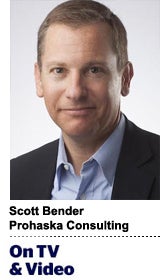“On TV and Video” is a column exploring opportunities and challenges in advanced TV and video.
Today’s column is written by Scott Bender, partner, global head of publisher strategy and business development at Prohaska Consulting.
As we hyper-target, we can’t forget to hyper-message.
While programmatic has revolutionized the way media is transacted over the past decade, we have yet to see the same transformation in creative. With an industry fixated on the right audience, place and time, we must also focus on how programmatic can deliver the right message.
For brands, it can mean data-driven executions that drive performance and customer relationships. For publishers, it’s an opportunity to enhance relationships with both their audiences and advertisers.
Programmatic creative can consist of several elements of creative development. In its broadest definition, programmatic creative applies programmatic solutions and best practices to the creative process.
There is, of course, dynamic creative optimization, where creative assets can be quickly assembled into multiple ad formats and messaging, based on data or machine learning, and measured in real time.
It can also just be about making the production of creative assets more efficient. Developing multiple creative executions, whether for TV or digital, has historically been a time-consuming and expensive proposition. Through programmatic creative, the ability to target different prospects in a given campaign has up to now far outpaced the number of creative units that can actually be developed, from an economic and personnel standpoint.
By leveraging a creative management platform, brands and their agencies can solve that problem. These tools enable the efficient production of multiple creative executions with variations that can range from hotel rates targeted after a specific airfare purchase, to simply using different colors in ads being served to certain regions.
For brands, it’s time to get the message right
As brands become more sophisticated audience buyers and leverage data themselves, the opportunity for the one-to-one personalization that dynamic creative can provide is more important than ever.
While we have seen strides from particular brands targeting products based on data like weather or geolocation, and dynamic creative in retail has been using browsing data for years, the ability to now dig into data that allows better prospecting is a reality. When a dynamic creative platform is connected to a brand’s website, demand-side platform and data management platform/customer data platform, they can collectively power a programmatic creative strategy that allows for more personalization and effective prospecting.
While many teams already think about this for display, the technology for video is growing daily.
The ability to have a multitude of TV spots in-market for pre-roll video, connected TV or over-the-top channels is now possible. Production of content at scale no longer has to be a financial burden or affect the quality of creative. Creative execs who feed these systems with the right assets and data will lead the way for a different type of creative strategy to take center stage.
For publishers, a new opportunity
As publishers look to maximize the value of every user or visitor, even beyond just ad revenue, the use of programmatic creative becomes a valuable tool. From targeting frequent visitors with subscription deals to ecommerce, the ability to target the right person – not just the audience segment – with the correct message gives house ads a whole new meaning and impact.
Combined with their own data initiatives, publishers can gain the same ability as brands to optimize their creative message for better performance, regardless of whether the objective is to sell a subscription or a T-shirt.
More than their own efforts, programmatic creative offers yet another reason for buyers and sellers to work in a more collaborative, less transactional arrangement. Publishers now have more than just inventory and first-party data to bring to the table, but also content assets that can create a whole new meaning for what constitutes native advertising.
Programmatic creative creates a better user experience and enhances ad performances for brands, their agencies and publishers. It’s time for the industry to get the right message.
Follow Prohaska Consulting (@TeamProhaska) and AdExchanger (@adexchanger) on Twitter.














